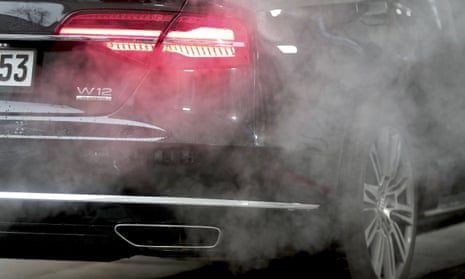100m highly polluting cars could appear on Europe’s roads after EU move
Exclusive: Efficiency recommendations of experts rejected in European Commission ‘Euro 7’ proposals

Almost 100m highly polluting cars could appear on Europe’s roads over the next decade after the European Commission moved to disown its own experts efficiency recommendations in a leaked proposal seen by the Guardian.
About 70,000 premature deaths in 2018 were caused by road transport emissions, mostly nitrogen oxides (NOx) and particulate matter (PM), and the commission had been expected to tighten pollution limits in the next “Euro 7” regulation, which takes effect in 2025.
A “medium ambition” option which would save €136bn (£119bn) in net health and environmental costs was touted, based on recommendations by an EU consortium of experts called Clove.
However, the draft Euro 7 regulation only proposes bringing diesel emissions into line with those for petrol cars in the existing Euro 6 law, while petrol standards would remain unchanged.
Anna Krajinska, the vehicle emissions and air quality manager for the Transport & Environment (T&E) campaign group said that the commission had reached its “very own Dieselgate moment”.
“The tearing up of its own expert group advice is a scandal and completely undermines the tightening of pollution standards for cars and vans,” she said. “The auto industry lobby has fiercely opposed Euro 7, using a variety of dirty tricks to influence decision-makers. Now the commission has caved into their demands. Carmakers’ profits are being prioritised over the health of millions of Europeans.”
The auto industry lobbied the commission intensely in the run up to the draft regulation, with one Volkswagen official last year painting “a picture of horror” to EU officials of the effect that tough standards could have, according to Der Spiegel.
“Women would have to be afraid [when] in dark garages in the future; accident victims would have to wait, trembling, for the ambulance; police officers might arrive too late at the scene of the crime. And all this, because cars would have to warm up their exhaust gas purification systems before they could be allowed to start … ” the German newspaper reported.
A spokesperson for the European Automobile Manufacturers’ Association said: “The industry is calling for an approach that is not only effective in terms of results, but that is cost-beneficial, while also addressing the huge challenges of meeting future CO2 targets. Vehicle manufacturers are going full-course ahead with the goal of carbon neutrality – it would be counter-productive to take away investments from this.”
The Euro 7 emissions standard, due to be published on 9 November, had been planned for four years as a replacement to the Euro 6, which was set in 2014, before the Dieselgate scandal.
Under the anticipated medium ambition option, NOx emission limits would have been cut from 60 to 30mg a km, with particulate matter limits falling from 4.5 to 2mg/km, based on new emissions technologies.
The draft regulation, which is being considered by commissioners and could change, says that this option was proportionate, cost-efficient and “the most effective” for cutting air pollution.
But it would also have raised petrol vehicle prices by 0.8% and diesel vehicle prices by 2.2% and “in light of current geopolitical and economic circumstances” the commission has “readjusted” it to put less “pressure on the automotive supply chain”.
Consequently, T&E estimates that up to 100m vehicles manufactured to Euro 6 standards for petrol cars could still be on Europe’s roads in the 2040s, potentially with access to low-emissions zones.
“If they won’t improve the shockingly weak proposal for cars and vans, it should be scrapped entirely,” Krajinska said.
Since the Euro 6 was applied in 2013, NOx road emissions have fallen by 22% for cars and 36% for lorries and buses, the draft regulation says. Particulate matter emissions have also fallen by 28% for cars and vans, and 14% for lorries and buses.

No comments:
Post a Comment